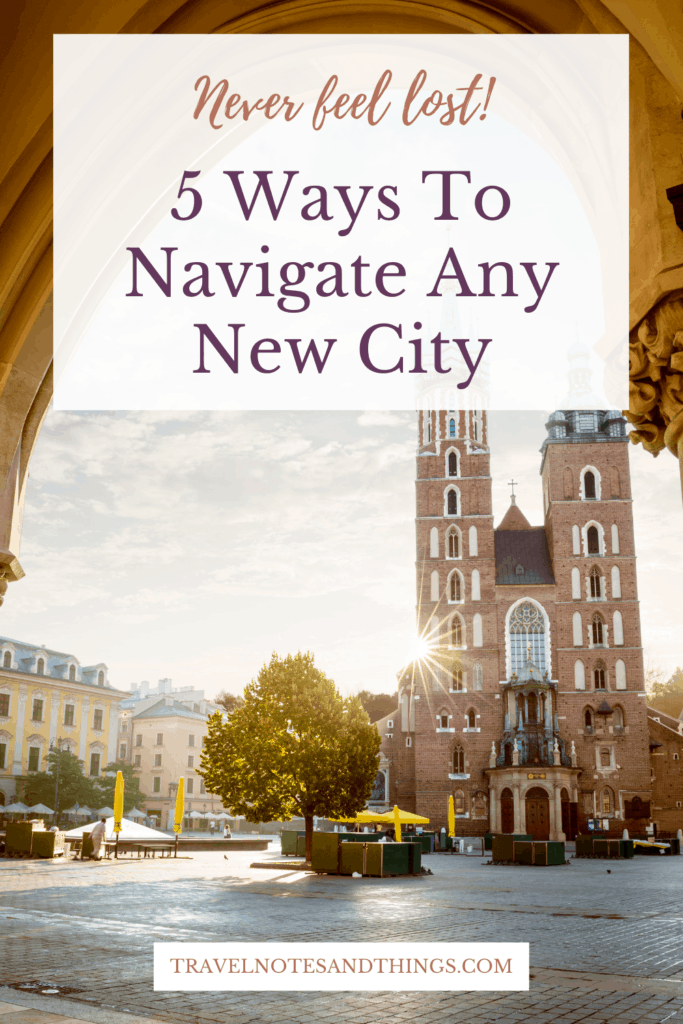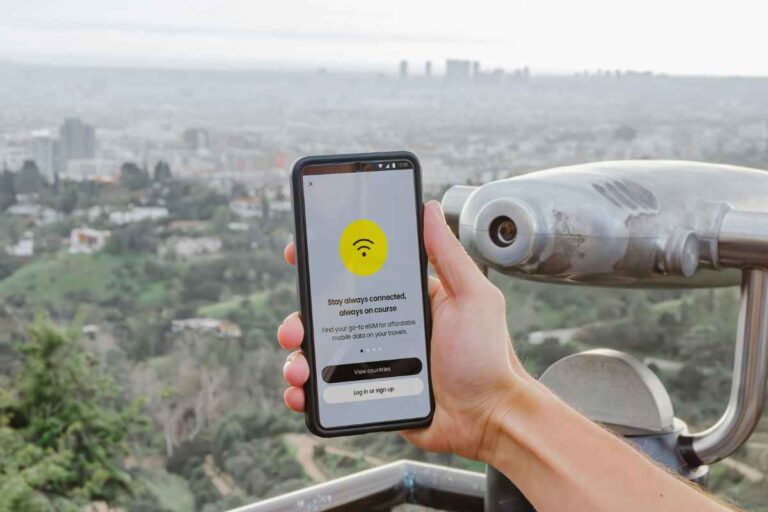5 Best Tried and True Tips For Navigating Any Foreign City
Updated December 2024
Nothing says “you’re really here,” like figuring out what the airport signs say when arriving in a foreign city. Am I right?
When those airport doors open up, exposing you to the smells of the city, foreign chatter, and hecticness of the airport, it can be easy to get caught up in the chaos and urgency of figuring out how to get to your lodging.
Not knowing how to navigate foreign norms, language, and culture! It’s not that easy, but it’s also not impossible to still navigate a foreign city.
But the thing is, you don’t have to figure it out from scratch every time.
You can easily and more confidently maneuver how to navigate a new city, whether you’re trying to figure out the public transport, how to get to your Airbnb from the airport, or vice versa, and so much more.
After 10+ years of traveling to and living in foreign cities, I’ve realized a few patterns and relied on certain tools when navigating foreign cities.
These patterns and tools not only help me navigate cities abroad time and time again easily, but I think they can also help you the next time you find yourself in a new city—whether you’re a first-time traveler or a seasoned pro!
In this post, I’ll share my best tips that you can implement the next time you are traveling to a foreign city.
Read below to learn about the 5 suggestions on navigating a foreign city that is tried and tested by yours truly!
If you have any questions about them, leave them in the comments below, and I will get back to you!
Also, stick around until the end for this post’s FREEBIE! It’s a good, practical one.
Let’s jump into the best 5 tried and true tips on how to navigate any foreign city.
1. Observe your surroundings

It’s like the saying, “In Rome, do as the Romans do.” When you find yourself in surroundings where you don’t understand the language and can’t read the script.
In these situations, you must rely heavily on other means of understanding the surroundings of the foreign city.
For instance, if you don’t know the proper etiquette for ordering coffee, pay extra attention to what others are doing.
Find a coffee shop with a somewhat long line, and use the people in front of you as a live example of how to make your order when it’s your turn.
Make sure to look around at what others are doing and see how they do it.
Do your research ahead of time and look up proper etiquette in other public situations, such as ordering at a restaurant or taking public transportation.
Check out blogs and YouTube videos and see what others have done. All the guesswork is taken out!
2. Use Google Translate to navigate those language barriers

Whether you’re at a coffee shop in Rome about to order or you’re using the metro in Madrid, getting around while trying to read a foreign language and/or script is no joke.
One app that’s helped me countless times, especially when I was in Bulgaria, where the script was so different, was Google Translate.
I especially loved the picture function, which allows you to take a photo of the sign you’re trying to read and then translate it for you in real time. This is so handy when traveling to a foreign city.
You can use this app offline, which makes it even more ideal for travel.
💡Pro tip: Make sure you have space for the offline capabilities on your phone, as you’ll have to download some keywords of the language you’re translating.
✅ Download Google Translate for FREE
3. Google Maps or Citymapper for finding your way around a foreign city

Google Maps has been my saving grace and worst enemy (simultaneously) when navigating around a foreign city because, honestly, as much as it has helped me, it has also gotten me slightly lost.
Though it’s imperfect, Google Maps is a good tool to have, whether connected to data or using the offline version. Use it as a co-pilot as you navigate wherever you may be.
Having Google Maps in my back pocket has given me the ultimate confidence in navigating a city, either by myself or with others.
Walking around a foreign city with the help of this app has allowed me to see different corners of a city, connect the other streets, and take public transportation without fear of not knowing how to get back.
It’s also worth mentioning that though Google Maps is the most common map app right now, there are also amazing alternatives and even better options than Google, especially in cities like London, where City Mapper seems to be the better choice.
I really like Citymapper, as it breaks down all the possible options to get from Point A to Point B based on budget, time, and other unique filters and options you’re looking for.
Although it’s not as widely available in many cities yet, it is available in some of the most popular cities in Europe, the UK, the US, Canada, and Mexico City (based on experience).
Here’s a full list of where you can use Citymapper for your reference.
✅ Download Google Maps and Citymapper for FREE
Read More: 28 Tips To Keep In Mind When Planning An International Trip
4. Learn a few keywords in the local language

Though you don’t have to go and fully learn the language of the city you’re visiting to have a good time, learning the basics can certainly get you much farther than you can imagine when traveling to a foreign city.
Let’s take this point to my situation while studying abroad in Athens, Greece.
My friends and I were exhausted from walking all day through Athens, so we took a taxi back to the Acropolis (where we were set to meet with the rest of the group).
We got into the taxi, and our driver didn’t speak or understand any English as we didn’t speak or understand any Greek. He looked at us blankly, and we returned the stare quietly (yes, it was awkward).
He then broke the silence when (we think) he asked us where we wanted to go.
My friend sitting shotgun said Acropolis with the most American accent you could think of (naturally), and of course, the blank stare continued.
I jumped in and said Ah-kroh-poli (using my Mexican Spanish accent), hoping it would sound the closest to Greek, and it worked!
Ah! Ναί! (yes!) he said, taking us to the Acropolis.
Other times, it was simply walking into a shop or a restaurant and greeting the shop owner with γεια σας (geia sas – hello) or saying ευχαριστώ (efcharisto – thank you).
I am really not trying to toot my own horn here, but my point is that it doesn’t hurt to learn how to say hi, goodbye, thank you, and other keywords you might think would be helpful.
Knowing another language, especially one in the Latin family, will also help you pronounce Greek words. So, all my fellow Latinos traveling the world, we can understand if we use our Spanish skills even in Greek!
It makes such a difference. Even with a different accent, locals appreciate when you try to speak their language. It shows effort, and they’ll even feel more inclined to help you or give tips on what to see and do in their city.
Plus, as travelers, it’s on us to learn a few words in the local language, not on the locals to fill in the gaps for us all the time.
It’s something I can’t stress enough.
Read More: Travel Planning Resources
5. Buy a good SIM card
Please check if your phone is unlocked or if you can get it unlocked before traveling to a foreign city.
You want an unlocked phone so you can use a local SIM and pay less for a better phone service abroad instead of using your home cell service.
Once your phone is unlocked, you can purchase a local SIM card and are free to use it anywhere in the world—for phone calls, text messages, and, of course, Google Maps/Citymapper, according to the type of local SIM card you have.
When I arrive in a foreign country, I first go to the nearest phone shop and buy a SIM card. You can also pre-purchase a local SIM card if you want to land extra prepared, which I’ve also done.
These phone shops/services are often located inside the airport, so you can get one as soon as you land, but most of the time, they will be overpriced. In my experience, if you can wait, get into the city, and visit a phone store.
You may be wondering how expensive they are, which is a great question!
They typically range in price, depending on what you want regarding minutes, data, local or international use, etc.
For example, when I lived in Spain, I got my SIM card from Orange and the “Mundo-Internacional” (World-International) plan. This plan worked in Spain and across Europe without extra charges—super convenient!
I paid 20 euros per month for this service and had around 6-7GB of data. I can’t remember how many minutes of calling time I had, but I mostly used WhatsApp to message people, which always worked well for me.
I was never left without minutes or data, and I relied heavily on my phone to explore.
Look up the most popular cell phone carrier networks in your destination to get a better idea of what that network offers, how to get one, prices and plans, and where they are located within the city.
Whether you’re planning to visit one or a few countries, I would research what those popular cell phone carrier networks are and do your research from there.
💡Pro tip: Many phones nowadays don’t have physical SIM card slots. In that case, you can opt for eSim cards. The most popular options include Airalo, Holafly, and Maya Mobile, which I’ve used and enjoyed.
Knowing this information before landing will save you time and stress. Trying to figure this out on the spot will probably leave you feeling tired and confused—don’t put yourself in that situation!
To make things easier for you, I created this SIM Card 101 sheet with helpful pointers on what to look for in a SIM card and some of the most popular cell phone carrier networks to look out for.
A boost in your research – all in this FREEBIE. Leave your info down below!
Also, if you’re planning a longer, multi-country trip and you don’t want the hassle of manually connecting to each country’s cell phone network, then definitely consider Drimsim.
Drimsim is the first-ever global SIM card available in 190 countries. It has no subscription price, so you only pay for what you use.
It’s the convenient, easy, and quick way to stay connected, use internationally and nationally, and so much more! Check out their pricing, custom phone number options, how to top off, how to order, and so much more!
Concluding thoughts on the best 5 best tried and true tips for navigating any foreign city
I hope these tips facilitate and boost your confidence the next time you do not know how to navigate a foreign city.
Also, don’t forget to download the beginner’s guide to understanding international SIM Cards.
This is a game-changer, as it has not only helped me navigate foreign cities but also made me feel confident enough to roam a new city and discover it even further.
I hope this guide serves you well and gives you a basic understanding of purchasing one for your travels.
To many more travel moments like these,

Like it? Pin it!









